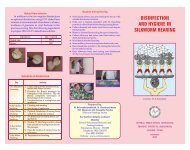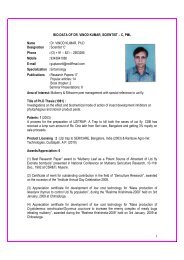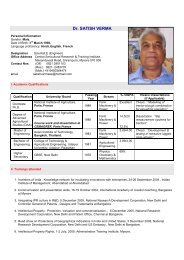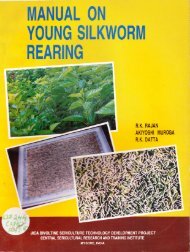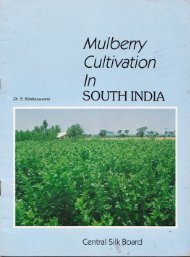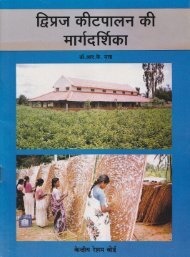BIVOLTINE RACE AND
Manual on Bivoltine Rearing, Race Maintenance and Multiplication
Manual on Bivoltine Rearing, Race Maintenance and Multiplication
- No tags were found...
You also want an ePaper? Increase the reach of your titles
YUMPU automatically turns print PDFs into web optimized ePapers that Google loves.
.- Freserve coeoonslpupae at optimurn ternperature (25'C) and hunridity (7&%j"<br />
-<br />
-<br />
-<br />
-<br />
-<br />
-<br />
-<br />
Conduet pupal gut examination immediatetry after the arrival of seed eoeCIons for the<br />
incidence eif Pebrine.<br />
Subject a sarnple of cococns froln eaeh lot to high temperature of 35"C for early eeloson<br />
and to facilitate eartry detection of pebrine. Test ti-re emerged moths for pebrine disease<br />
to eliminate risk and wastage of l*hslur'<br />
Cut open at one end of the coer'ron to remove the pupa for determining the sex"<br />
Normatrly sexing is done rnanually by visual examination of their sexual markings.<br />
Cut and separat,e the eoeoons at least three days before emerge$ce" nt is especially<br />
irnportant for raees sherwing above ZAVo e*co*n siretrl ratic]"<br />
Preserve the seed pupae ilr trays in single laver om eorrugarad paper or powclered paddv<br />
husk (Fig.16).<br />
Cgver the pupae rvith perforated news paper $ne day prior to emergenee to facilitate<br />
the emerged ryrcths eolrie on the paper and eoll*ction cf in*tFrs becorne easy. Besides,<br />
this helps in absorption *f urine, while pieking.<br />
1S.1. Mc€fu emergenee<br />
- fu{ot}rs emerge t2-L3 enays {roclrn temperature 24-25'{} from the day of spinning.<br />
Emergenee starts early in pciyvoitines {1S-11 days} than bivoltines t12-13 days)"<br />
-<br />
trn e ase af Pure Mys*r*, sinee the coeoon'sheli Iayer is soft, sex seflaration is litttre difficult<br />
(beeaus* pupa ffia'f b* *iamaged whiie cutting ttre eocoon shell). But as the rnatre and<br />
fernale rir*ths *r$erg* at tw'o disiinet peaks they are con:fortably eclleeteel sellarately"<br />
1 {}.2 "<br />
Symeha"elmi s a€$$ra sf xs?s$fu ersa*rgex? ee<br />
Planning for synctrrrcidsatiCIn should start at the bmshing time of parental breeds.<br />
-<br />
trf the cocooils are meant fcr hy-brid preparation, tteen the total incubation, rearing period<br />
and ernergence of moths are to b'e caleulated and a*cordingly the durnbbeli lines are<br />
bnrshed two days earlier than oval lines, sc ttrat maie and femaie rnoths are readily<br />
available for hybridisaticn. Sometimes ttrere ma_v be difference in the spinning Erf the<br />
two bresds due t* the rearing conditions " {n such easss, the ernergenqe clf moths in the<br />
twqr trreeqis can be adjusted by selecting cocoons of matei:ing spinning date.<br />
* If the symehr*nisation is to be done at perpal stage, the pupae shouid be refrigerated,<br />
preferably tr day' prior to emergence, for fcur tc six days (maximurn) at 5 to 1S'C"<br />
1S"3. Coupling<br />
-<br />
-<br />
Keep ccupl*d moths uneXisturbeel for 3-4 hours in iltrumainated and well ventilated place.<br />
Maintain temperature anetr hurnidiry at 23-25"C an& 7&^75% respectively.<br />
Gently tap the decoupled fernale moths to induce urinaticn.<br />
* Cold store the maie moths irnrnediately after separation at 5"C upto 3-4 ctrays .<br />
?7




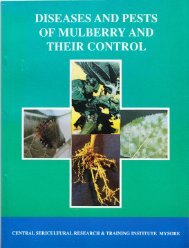

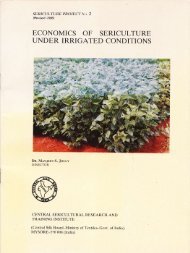
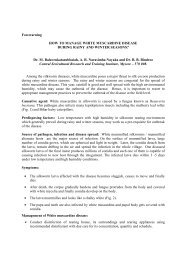
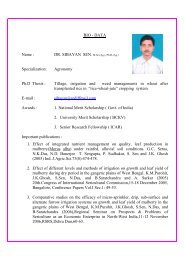
![E}A]\GALORE](https://img.yumpu.com/54052619/1/190x260/eagalore.jpg?quality=85)
